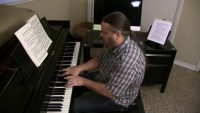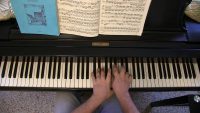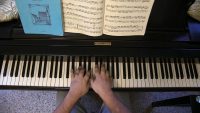Découvrez la vidéo J.S. BACH: Prelude & Fugue in C Major, WTC 1 de BachScholar sur Le Fil YouTube de Piano Partage.
ESSAY ON BACH'S TEMPOS: I am the only scholar in the world who knows Bach's planned tempos (tempi), which I demonstrate in this Prelude & Fugue. Notice how both this Prelude and Fugue both last exactly two minutes. This is what I call a "1:1 duration ratio" which was Bach's most common technique of unification. The tempos are totally different, yet they both result in the same durations. The Prelude has Bach's "Moderato" speed of 72 bpm (his more common "Allegro" was a bit faster at 84 bpm) while the Fugue has Bach's most common "Andante" speed of 54 bpm.
Some theorists and scholars have proposed the rule that Bach's preludes and fugues should have a similar or equal tempo to unify them; however, this is wrong. Bach planned the tempos to be substantially different -- for example, this Fugue is a full 18 bpm slower than the Prelude, yet these different tempos result in equal total durations.
I deciphered Bach's ingeniously clever and secret system of tempo and duration way back in 1992 but my theory has been pretty much "in hiding" for 20 years due to other obligations. Basically in a nutshell, Bach almost always sought "duration ratios" between preludes and fugues or arias and choruses in cantatas or movements in chamber works. The "duration ratio" in this Prelude & Fugue is one of Bach's most common, which is two minutes even. That is, when the Prelude is played at a moderate speed of 72 bpm and the Fugue is played a slower andante of 54 bpm this results in durations of two minutes each.
Thus, my analyses of Bach's complete works over about a 10-year period reveals that Bach knew all of his standard tempos in beats per minute (there were about a dozen of them) and planned his works with particular tempos in mind, which then allowed him to calculate how many measures to aim for when composing the work. For example, Bach's "target" number of measures for this Prelude was most likely 36 measures and for the Fugue was most likely 27 measures, since at 72 and 54 bpm with these numbers of measures result in mathematically perfect two minutes each. Bach didn't always hit these target number of measures exactly, such as in this Prelude & Fugue (35 instead of 36); however, many times he did and when he was off it was usually only up to three measures at the most. It is significant that this is the first Prelude & Fugue, so it makes sense that if in any Prelude & Fugue Bach would have chosen this pair to demonstrate his ideal 1:1 duration ratio at two minutes each. This was a very common duration plan for shorter pieces like preludes and fugues.
To summarize, Bach was a great "musical architect" who knew his standard tempos and planned his tempos and numbers of measures in order to achieve his most common "duration ratios" of 1:1, 1:2, and 2:3. I am the only scholar in the world who has figured out Bach's secret system, which I plan to publish sometime in the near future!








